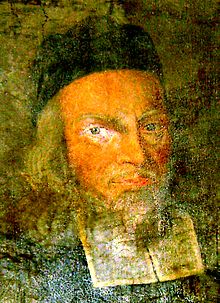Johann Heinrich Haevecker
Johann Heinrich Hävecker (born August 20, 1640 in Calbe / Saale , † July 18, 1722 ibid) was a German theologian and chronicler.
Education
Johann Heinrich Hävecker - son of Heinrich Hävecker, pastor of St. Petri Church in Brumby - studied first in Helmstedt and later, like father and brother, in Wittenberg . There he obtained on June 23, 1663 with Balthasar Stolberg (1640–1684) the master's degree with a philological exercise on Matth. 3.4 about John the Baptist.
Professional background
In 1665 he became rector of a school on Kirchplatz, roughly at the point where the Heinrich Heine School later stood in Calbe adS, 1681 deacon (second pastor), 1693 pastor primarius (first pastor) of St. Stephen's Church and at the same time Church inspector of the Holzkreis .
In this function, which was associated with numerous business trips, he was responsible for inspecting the 40 parishes and their schools in his administrative district (today part of Saxony-Anhalt ). The knowledge gained in this way flowed into the Chronica and description of the cities of Calbe, Acken and Wantzleben, which was published in 1720, was reprinted repeatedly and is still important today as a historical source .
Appreciation
From today's perspective, his literary work is more important than Hävecker's post. In addition to the university literature mentioned and his chronicle, he published a repeatedly reprinted catechism, Christian edifying literature, works on the history and theory of the sermon (homiletics) and hymns.
His first extensive work of more than 840 pages was the Lilium physico-theologico-hieroglyphicum , which appeared in 1669 when Hävecker was 29 years old. The writing about the lily as a symbol of the Mother of God stands in the tradition of the attempt by physicotheologists to use scientific - here: botanical - knowledge in order to prove God's properties from his work of creation. The natural sciences and the revealed religion, the “book of nature” and the Holy Scriptures are brought together in this early enlightenment approach.
From 1685 he emerged as editor and proofreader of the writings of his father-in-law, the aforementioned theologian, inspector of the wood circle and court preacher Christian Scriver . As an edifying and folk writer, Scriver exerted a great influence on his contemporaries and posterity. Through his criticism of the damage and outward appearance of the Lutheran Church, he became a pioneer of pietism . Scriver's “Glory and Bliss of the Children of God” experienced numerous editions in Hävecker's adaptation and was re-edited in 1730 and 1864 after the death of the author and editor. His “Seelen-Schatz”, a collection of his Magdeburg weekly sermons, was 12th edition in 1744.
In 1703, Hävecker commented on the unification of Lutherans and Reformed (Calvinists) in several writings under the pseudonym Irenaeus Christophilus through his "harmless peace thoughts".
literature
- unknown author: Hävecker, Johann Heinrich . In: Allgemeine Deutsche Biographie (ADB). Volume 11, Duncker & Humblot, Leipzig 1880, p. 113.
- Bernhard Pabst: Heinrich Haevecker, Johann Heinrich Haevecker. "... that one has, as it were, a little Biebel in such beautiful paintings and pictures ...". The baroque village church Brumby in circles Schoenebeck / Elbe and the parish family Haevecker - the historical description in the fair preaching 1671. . Art historical documentation on St. Peter's Church in Brumby (PDF download), 110 pages, A4 format. With an introduction by Bernhard Pabst. Bonn 2006
Varia
His portrait, which had been considered lost since the beginning of the 1980s, was rediscovered in 2010 in a state that was in dire need of restoration.
Web links
- Publications by and about Johann Heinrich Hävecker in VD 17 .
- Detailed biography and catalog raisonné ( PDF file ; 661 kB)
| personal data | |
|---|---|
| SURNAME | Hävecker, Johann Heinrich |
| BRIEF DESCRIPTION | German theologian and histographer |
| DATE OF BIRTH | August 20, 1640 |
| PLACE OF BIRTH | Calbe , Saale |
| DATE OF DEATH | July 18, 1722 |
| Place of death | Calbe , Saale |

